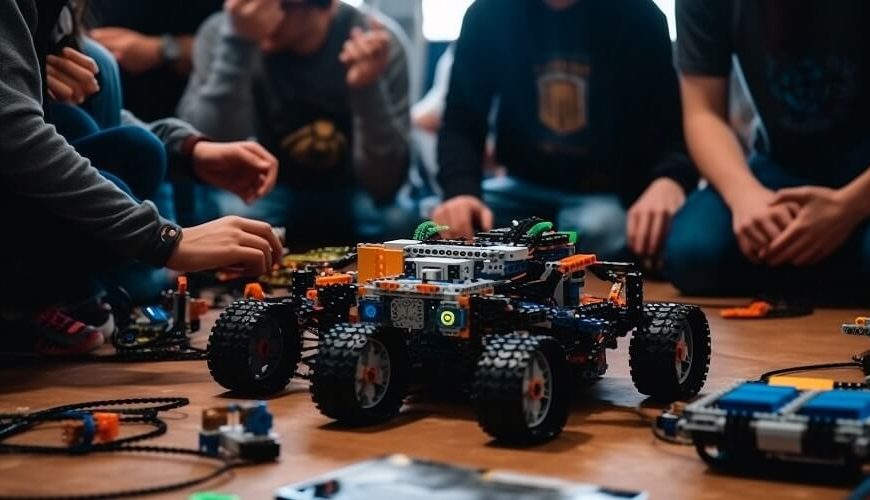In today’s fast-paced, tech-driven world, it’s becoming increasingly important to equip our younger generation with skills for the future. Among these skills, robotics stands out as an essential discipline. The domain of Robots for Kids is not just about shiny, whirling machines. It’s about shaping young minds to think, innovate, and understand the complex interplay between technology and human life.
Why the Buzz About Robotics for Kids?
The idea of introducing robots to children might sound futuristic, but in truth, it’s a logical step forward in our technological journey. Think about the toys children play with today. Many of them are integrated with some form of technology, from remote-controlled cars to interactive dolls. Robotics for kids is an extension of this trend but with a more educational slant.
Understanding the Importance of Robotics
The importance of robotics in today’s world cannot be understated. Robots are prevalent in industries, homes, and even in space exploration. They make tasks easier, quicker, and more precise. By integrating robotics in the educational paradigm, we are essentially preparing kids for a world that heavily relies on automated systems and AI-driven solutions.
Moreover, when children interact with robots or design them, they’re not just learning about machinery. They delve into problem-solving, computational thinking, and creativity – skills which are essential in almost every professional field today.
Tapping into STEM Through Robots
STEM, an acronym for Science, Technology, Engineering, and Mathematics, has been a focal point of education for several years now. The introduction of robotics for kids directly aligns with the STEM curriculum, making it a seamless inclusion in children’s learning.
When children engage in creating or programming robots, they get hands-on experience in engineering and technology. They learn about science when they comprehend how sensors work or how weight distribution affects a robot’s balance. Mathematics comes into play when they calculate distances or angles for their robot’s movement.
Benefits of Robotics for Kids
Enhancing Problem-Solving Skills: When a child is tasked with making a robot move or perform a certain action, it often involves a series of trials and errors. They learn the importance of persistence, logical reasoning, and innovative solutions.
Promotion of Creativity: Robots for kids aren’t always about following a set pattern. Many robotic kits allow children to design their robots, fostering creativity and individual expression.
Teamwork and Collaboration: Robotics for kids often involves group projects where children need to collaborate, discuss ideas, and come to mutual agreements.
Learning Real-World Applications: Robotics makes abstract concepts tangible. Concepts like coding, physics, or mathematics, which might seem difficult on paper, become relatable and easier to grasp.
Preparing for the Future: As we have reiterated, the importance of robotics in the contemporary world is immense. Children familiar with robotics will naturally have an edge in numerous professional fields.
Real-life Examples: Robots for Kids in Action
Across the UK, there are numerous workshops and after-school programmes centred around robotics for kids. For instance, a school in London recently hosted a robot-making competition. The students, ranging from ages 7-12, were tasked with creating robots that could perform simple chores. The outcome was an array of innovative designs, from robots that could sort toys based on colours to ones that could water plants. Such endeavours highlight the immense potential our kids hold and the wonders of introducing them to the world of robotics.
The Psychological Impact of Robotics on Kids
One of the often-overlooked aspects when discussing robotics for kids is the psychological and cognitive development it fosters. When a child successfully builds or programmes a robot, there is a sense of accomplishment. This enhances their self-esteem and instils a belief that they can tackle complex problems.
Furthermore, robots have also been used as therapeutic tools for children with special needs. Their predictable nature can be comforting, allowing these children to engage in social interactions at their own pace. For instance, robot-assisted therapy has shown promise for kids with autism, helping them improve their communication skills and reduce anxiety in social settings.
Safety First: Navigating the World of Robotics for Kids
As we usher our children into this new frontier, it’s essential to understand the safety aspects of robotics. Parents and educators must ensure that the tools and kits used are age-appropriate. Small parts can be a choking hazard for younger kids, while more complex kits might lead to frustration if introduced too early.
It’s also vital to maintain a balance. While the benefits of robotics for kids are manifold, children also need time away from screens and gadgets. Physical play, outdoor activities, and traditional forms of learning remain crucial.
From Toys to Life-Changing Solutions
The field of Robots for Kids is not restricted to toy robots alone. Many institutions are leveraging this interest to channel the young minds towards bigger global issues. For instance, there are programmes where children are tasked with designing robots that can help in environmental conservation or assist in medical surgeries.
By engaging kids in such real-world problems, we’re not only enhancing their learning experience but also making them socially conscious. They begin to understand the broader implications of technology and its potential to bring about meaningful change in society.
The Global Perspective: Robotics Beyond Borders
While we’ve touched upon the scenarios in the UK, it’s heartening to note that the trend of robotics for kids is a global phenomenon. From Asia to America, schools and institutions are integrating robotics into their curriculum. This global movement ensures that our children will be part of a generation that speaks a common language – the language of innovation, problem-solving, and technological prowess.
Incorporating Robotics at Home
The classroom isn’t the sole domain for robotics. Parents can actively participate in their child’s robotic journey. Simple robot kits are available that families can assemble together, turning it into a fun bonding activity. It provides an excellent opportunity for parents to nurture their child’s curiosity and learn alongside them.
Conclusion
The realm of robots for kids is vast and filled with potential. By merging play with education, robotics offers a unique opportunity for holistic learning. Understanding the importance of robotics and the numerous benefits of robotics for kids is pivotal for parents, educators, and policymakers alike.
With institutions like EuroKids Preschool incorporating tech-driven approaches in their curriculum, the future indeed looks promising. At EuroKids Preschool, the emphasis is not just on traditional learning but also on shaping young minds to be ready for the world of tomorrow. A world where robots might just be as common as textbooks!















